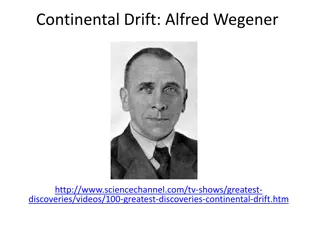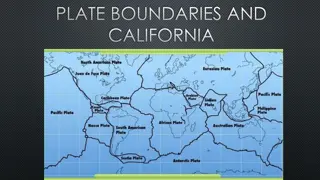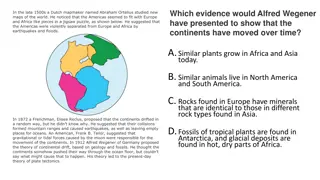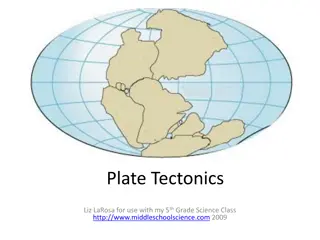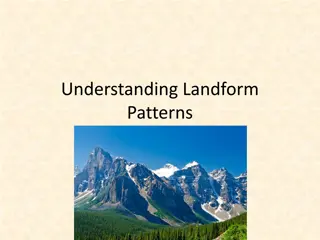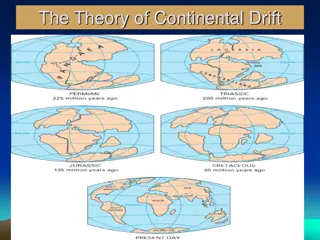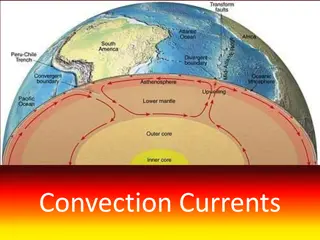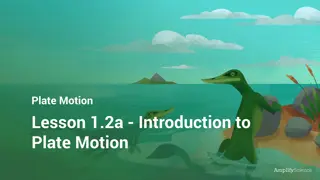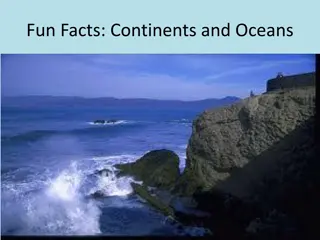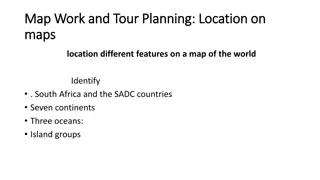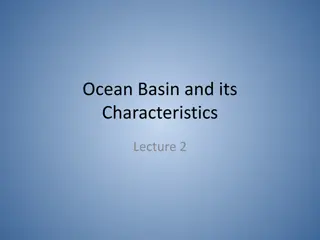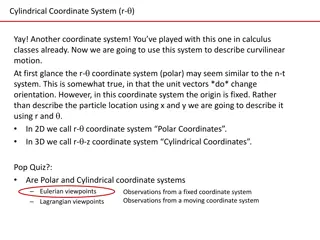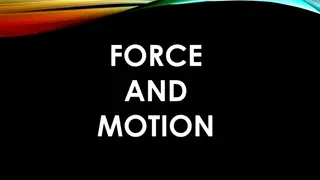The Theory of Plate Tectonics: Continents in Motion
Earth's crust and lithosphere have changed over geologic time, forming tectonic plates that move due to convection currents. The concept of plate tectonics explains how continents fit together, the existence of a supercontinent called Pangaea, and natural phenomena like earthquakes and mountains. Early scientists noted continental configurations akin to a puzzle, leading to the theory of continental drift and the confirmation of tectonic plate movements through fossils and seismic data.
Download Presentation

Please find below an Image/Link to download the presentation.
The content on the website is provided AS IS for your information and personal use only. It may not be sold, licensed, or shared on other websites without obtaining consent from the author. Download presentation by click this link. If you encounter any issues during the download, it is possible that the publisher has removed the file from their server.
E N D
Presentation Transcript
Earths crust has changed throughout geologic time. Earth s crust and the solid part of the mantle form the lithosphere. The lithosphere is where volcanoes and mountains form. The lithosphere can break because it is fragile. It breaks up into thick, moving slabs of rock called tectonic plates Tectonic plates fit together like one big jigsaw puzzle. The study of how the plates move is called plate tectonics. tectonic plates. plate tectonics.
Tectonic plates move by convection currents that form deep in Earth s interior. The currents bring heated material upwards while pulling cooler material down towards the interior of the Earth. The heating and cooling motions move the overlying crust along. The rate of movement is about 1-9 cm per year. convection currents
http://www.teachersdomain.org/asset/ess05 _vid_plateintro/
Do you think that the way continents fit together is convincing evidence for the theory of plate tectonics? Why or why not? What was the supercontinent called that once contained nearly all of the continental crust? How does the theory of plate tectonics help us explain natural phenomena such as earthquakes and mountains, which geologists had difficulty accounting for prior to the development of the theory?
Early scientists studying the configuration of the Earth noted how the continents appeared to look like a puzzle. The pieces are now separate but could fit together. In 1915, a scientist named Alfred Wegener the concept of moving continents. He also came up with a theory that all the Earth s land masses were once part of a supercontinent, called Pangea Alfred Wegener introduced Pangea. .
Pangea broke up over millions of years and became the Earth that we now live on. This theory is called continental drift theory scientists confirmed Wegner s idea by linking fossils and rock units between land masses now separated by great distances. Similar fossils and rock units could only occur if the land masses were once joined together. Seismic data from around the world was used to show the presence of fractures in Earth s crust. It showed where earthquakes and volcanic activity were occurring. Today there are 17 major tectonic plates on Earth. continental drift theory. Later
http://www.teachersdomain.org/asset/ess05 _vid_wegener1/
Think/Pair/Share Working with your partner answer the following questions and be prepared to share them with the class. What did Wegener propose as a method of explaining the close fit of the continents on either side of the Atlantic Ocean? What was so unusual about the fossil remains of Mesosaurus? How did clues found in South Africa and Arctic islands support Wegener's theory of continental drift? Why wasn't Wegener's theory accepted at the time?
The movement of tectonic plates has major consequences for the plants and animals that live on Earth. When a plate moves, the plants and animals that live on the plates also move. Environmental conditions (like sunlight, temp, and rainfall) change in response to the tectonic plate movement. A plate located near the equator would have lots more sunlight and be warmer than a plate located at one of the Earth s poles.
When land masses join, diversity (different species) decreases. In a large space, organisms can easily find suitable habitats. When land masses break apart, diversity increases. Organisms on a small landmass must make do with the current habitat. They cannot move to a new space and must survive under challenging, stressful conditions with limited resources. Smaller landmasses may have fewer competitors or predators.
Most natural environmental change is slow. The formation of the Isthmus of Panama took 12 million years to complete. This allows organisms the opportunity to change to fit their new environment. The gradual changes of an organism, from one form to another over many generations, form the process of evolution. idea of evolution was Charles Darwin. evolution. The first person to propose the
Charles Darwin traveled the world observing living animals and fossils on different continents. These observations and many years of study allowed him to propose a valid mechanism explaining how organisms change from one form to another.
Your teacher will give you a set of cards. Half of the cards will be an organism and it s problem. The other half will be the solutions that the organism evolved overtime so that they could survive. Try to match up the correct organism to the correct evolutionary process.
Natural Selection Darwin repeatedly observed how environmental pressures can change the way an organism naturally interacts with its environment. He developed the theory of evolution from his studies. Evolution many generations. It is a result of natural selection. The process of natural selection organisms best suited to the environment will be most likely to survive and produce offspring. Evolution is the modification of organisms over process of natural selection states that the
Natural Selection Darwin realized that organisms must compete for resources like food, water and space. Those organisms that perform the best are most likely to get food, water and space and will live longer lives and produce more offspring. Scientists call the ability of an organism to live, survive and reproduce in a particular environment fitness. Not all individual animals within a population have the same fitness.
Natural Selection- This variation produced through sexual reproduction makes some organisms more fit than others. These different characteristics determine the chances of an organisms survival. This is where the idea of survival of the fittest Organisms that are the fittest will live the longest and produce the most offspring. Favorable traits that help the species survive are called adaptations. An adaptation can be a physical structure or a behavior. Adaptations are inherited by organisms, and they help the organism to survive. survival of the fittest comes from. adaptations.
Competition- According to Darwin, competition driving force behind evolution. The interactions between different species and between individuals of the same species cause some organisms to survive while others perish. Resources like food, water and sunlight are limited this causes organisms to compete to obtain the resources. competition is one main
Environmental Impact On Organisms- Ostriches Emus
Ostriches and emus are 2 similar looking birds found on 2 different continents. One lives in Africa and the other lives in Australia. DNA evidence confirms these 2 birds are related. They are flightless birds that came from a prehistoric continent called Gondwanaland. This was a massive supercontinent that formed about 550 million years ago and it included most of the continents that now make up the southern hemisphere.
When it broke up about 200 million years ago, the animals living on these land masses traveled to their current locations. Each bird population found itself living in a new environment. They now had new environmental pressures to deal with. These modern birds are descendants of a common ancestor that once lived on Gondwanaland. These birds show common genetic, behavioral, and physical characteristics.
The ostrich, emu, rhea, cassowary and kiwi are all members of the same order of birds. They share some similarities and have some differences. Ostrich and cassowary are boldly colored Emu and rhea are camouflaged Cassowary is smaller because it lives on an island Ostrich is taller Ostrich has lost a toe and emu has not Cassowary s feathers are more like hair to protect the bird from plants
The individual physical traits are not modified by the bird. Rather, the birds that were born with the trait that is favored by the current environmental pressures survive and pass that trait on to their offspring. This ensures that over time, the expression of the favored trait becomes more pronounced, and birds lacking favored traits die off.
Often when populations are geographically separated, like the ostriches and emus, 2 new populations are formed. The 2 new populations are physically separated and can no longer breed with the lost members. This means that some traits can quickly predominate in a population because of the closed breeding system. This increases the rate at which species change.
Theories of evolution can also be supported by anatomical similarities or the similarities in the structure of living things. Homologous structures: are parts/organs that are similar in shape and have developed from a common ancestor but do not perform the same function. For example, human arm and wing of a bird and flipper of a whale all contain the same bones
Vestigial organs: structures that are no longer used or have greatly decreased in importance. For example, a whale and some snakes have a pelvis and femur, which are structures necessary for walking. But they do not walk. Their presence suggests a common ancestor. Analogous structures: are similar in function but they come from different ancestors. The porpoise (mammal) and the shark (fish) both have long smooth bodies and fins which closely match in appearance and function but they did not come from the same ancestor.



